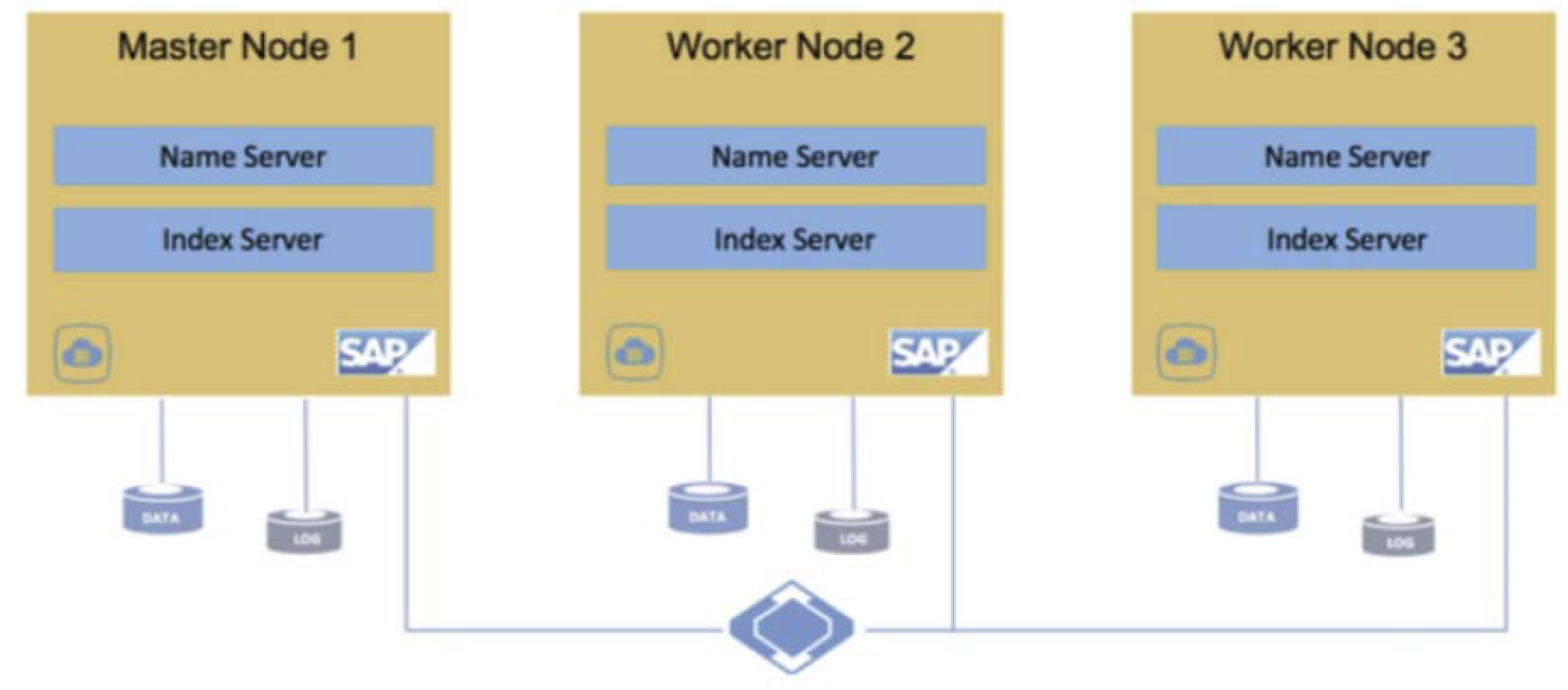Halaman ini mencakup informasi tentang melindungi HANA 1+n dan scale-out HANA.
Melindungi HANA 1+n
Untuk melindungi cluster replikasi HANA 1+n sebagai satu aplikasi, aplikasi
memiliki host cluster sebagai sid name_cluster setelah penemuan aplikasi. Misalnya, jika sr1 adalah instance HANA, maka nama aplikasi adalah sr1 dan nama host adalah sr1_cluster dalam daftar App Manager Applications.
Tujuan pencadangan log HANA harus dibagikan di antara dua node. Saat failover terjadi, pencadangan database dan log akan otomatis di-failover ke instance primer saat ini, dan pencadangan log dilakukan dari instance primer saat ini, yang mencatat log terakhir dari instance primer lama serta log baru dari instance primer baru. Ikuti langkah-langkah persiapan di Menyiapkan database SAP HANA untuk perlindungan.
HANA 1+n selalu ditemukan sebagai aplikasi cluster yang berisi semua detail node dalam metadata. Sebaiknya jalankan penemuan paksa setelah ada perubahan pada konfigurasi node cluster, seperti setelah menambahkan atau menghapus node dari cluster. Jika node dihapus atau ditambahkan setelah penemuan dan perlindungan, konfigurasi tidak akan diperbarui secara otomatis dalam metadata Backup dan DR, dan dapat menyebabkan masalah pencadangan.
Prasyarat untuk melindungi instance dan database SAP HANA 1+n
Sebelum melindungi instance SAP HANA, pastikan hal berikut:
- Jika host telah mengonfigurasi IP virtual, tambahkan hanya IP virtual dan nama host host utama selama penemuan.
- Agen Backup and DR harus diinstal di semua node.
- Port harus dibuka di host untuk mengizinkan komunikasi di port 5106. Hal ini memerlukan aturan firewall traffic masuk dengan appliance pencadangan/pemulihan sebagai sumber, host yang menjalankan agen sebagai target, dan port target adalah 5106. Selain itu, tidak perlu menambahkan port 5106 ke aturan ingress default yang dibuat untuk appliance, karena hal ini menentukan appliance sebagai target.
- Lokasi pencadangan log HANA harus ditetapkan di NFS bersama.
Melindungi penyebaran skala HANA

Prasyarat untuk melindungi instance penyebaran skala SAP HANA
Sebelum melindungi instance penyebaran skala SAP HANA, pastikan hal berikut telah selesai:
- Jika host telah mengonfigurasi IP virtual, tambahkan hanya IP virtual dan nama host terkait dari host utama selama penemuan.
- Agen Backup and DR harus diinstal di semua node.
- Port harus dibuka di host untuk mengizinkan komunikasi di port 5106. Hal ini memerlukan aturan firewall traffic masuk dengan appliance pencadangan/pemulihan sebagai sumber, host yang menjalankan agen sebagai target, dan port target adalah 5106. Selain itu, tidak perlu menambahkan port 5106 ke aturan ingress default yang dibuat untuk appliance, karena hal ini menentukan appliance sebagai target.
- Untuk pencadangan berbasis file backint—Penuh+Inkremental—lokasi pencadangan log HANA harus disetel ke bersama—NFS. Lihat Menambahkan host ke konsol pengelolaan.
Untuk perlindungan snapshot penyimpanan
- Volume data dan log tidak dibagikan di semua node
- Volume data dan log dikelola oleh pengelola volume logis (LVM)
- Pastikan direktori mnt000* ada di titik pemasangan lokal untuk mengidentifikasi node primer dan sekunder
Ikuti prosedur penyiapan di Menyiapkan database SAP HANA untuk perlindungan.
Dokumentasi Backup and DR Service untuk penyebaran skala SAP HANA
Halaman ini adalah salah satu dari serangkaian halaman khusus untuk melindungi dan memulihkan instance scale-out SAP HANA dengan Layanan Backup dan DR. Anda dapat menemukan informasi tambahan di halaman berikut:
- Backup and DR untuk SAP HANA scale-out
- Menyiapkan instance penyebaran skala SAP HANA untuk pencadangan
- Menambahkan host penyebaran skala SAP HANA, serta menemukan dan melindungi databasenya
- Mengonfigurasi format disk penahapan dan metode pencadangan untuk penyebaran skala SAP HANA
- Menetapkan detail dan setelan aplikasi untuk instance penyebaran skala SAP HANA
- Mencadangkan database scale-out HANA 1+n dan HANA
- Memulihkan dan memulihkan instance penyebaran skala SAP HANA
- Memasang cadangan penyebaran skala SAP HANA sebagai pemasangan standar
- Memasang cadangan penyebaran skala SAP HANA sebagai database virtual
- Memasang dan memigrasikan cadangan penyebaran skala SAP HANA untuk pemulihan instan ke target mana pun

